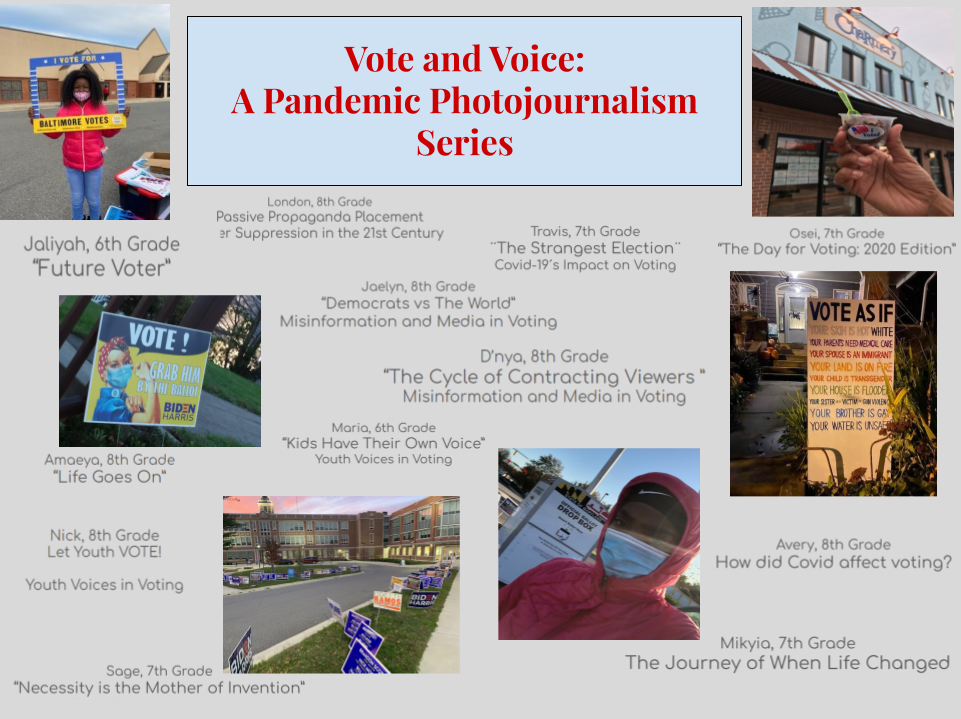This unit was created by Cortnie Belser, a humanities teacher at City Neighbor Charter School in Baltimore, MD, as part of the fall 2020 Pulitzer Center Teacher Fellowship program on Media, Misinformation, and the Pandemic. It is designed for facilitation across approximately six 60–90 minute class periods.
For more units created by Pulitzer Center Teacher Fellows in this cohort, click here.
Objectives:
Students will be able to...
- Identify the role of a photojournalist and the role of photojournalism in documenting the pandemic and the 2020 election
- Identify, research, and analyze social justice issues that are surfacing before and after the 2020 election
- Utilize photojournalism storytelling document and communicate an underreported story that is important to their communities during 2020 elections
- Write a persuasive letter or portfolio cover letter that captures their central ideas as they relates to a topic in voting and/or underreported voices.
- Present their work to authentic peer and public audiences
Unit Overview:
As part of this six-lesson unit, students analyze news stories on the COVID-19 pandemic and practice photojournalism skills. They evaluate the ways that images are researched and composed to communicate underreported stories, analyze how text and images work together to communicate stories, and reflect on ways that they can communicate the impacts of elections and the pandemic in their communities through composing their own photos. In the end, students create two photography projects and curate a final portfolio. They also evaluate reporting on the following themes:
- Voter Suppression in the 21st Century - Big Questions:
- What do people do to prevent others from voting?
- What is voting fraud?
- How can people sway an election?
- Covid’s Impact on Voting - Big Questions:
- How has COVID-19 changed how people vote?
- What positive impacts has COVID-19 had on the campaign process?
- How has COVID-19 impacted people’s mindset surrounding voting?
- Misinformation and Media in Voting - Big Questions:
- Where do people get their news? How does news reporting impact voters?
- How do people know if news is real or fake?
- What misinformation has impacted this election?
- Youth Voices in Voting - Big Questions:
- Should young people be able to vote?
- What do young people think about voting?
- What issues impact young people?
Resources for Facilitating this Unit:
Click here for a PDF outlining lesson plans for this unit, including warm-ups, resources, discussion questions, activities, performance tasks, and student workfor the unit.
Performance Tasks:
1. Students compose two Photo Walk Guides. The 2 Photo Walk Guides are (1) The Impacts of the Pandemic (Instructions) and (2) Voting & Election Week (Instructions).
2. Students compose final photo portfolios that include 3-5 core photos. Each of the students' portfolios include:
- An photojournalism portfolio title
- A descriptive 1-2 sentence photo caption for each image
- A cover letter that includes their artist’s statement and purposes of their exhibitions
3. Optional: For students who were unable to gather photos for a final portfolio, students utilize their photo walk experiences and topics in voting research to write two letters to two audiences.
4. All students identify at least 1-2 authentic audiences (peers, family, essential workers, interviewed people, an organization, political representative, etc) to invite, and share their work with, as part of a culminating unit exhibition of learning. Students will be required to complete a peer review and unit reflection.
Here are examples of work by students from City Neighbors Charter School in Baltimore, MD who participated in the unit in fall 2020:
- Here are photo stories by students from City Neighbors Charter School in Baltimore, MD that were created as part of the Pandemic Photo Walk performance task.
- Here are photo stories by students from City Neighbors Charter School in Baltimore, MD that were created as part of the Election Photo Walk performance task.
- Here are examples of notes from students at City Neighbors Charter School in Baltimor, MD for lesson 3 (Topics in Voting)
- Here are examples of final projects from students at City Neighbors Charter School in Baltimor, MD
Assessment and Evaluation:
Students receive feedback on their portfolios and writing through one-on-one discussion with the teacher, and comments added directly to the projects by the teacher. Students also use this graphic organizer to offer feedback on each other's projects.

Educator Cortnie Belser offers feedback on a students' project using the comment function from Google Slides. Screenshot by Cortnie Belser. United States, 2020.
Standards:
CCSS.ELA-LITERACY.RI.8.2
Determine a central idea of a text and analyze its development over the course of the text, including its relationship to supporting ideas; provide an objective summary of the text.
CCSS.ELA-LITERACY.RI.8.3
Analyze how a text makes connections among and distinctions between individuals, ideas, or events (e.g., through comparisons, analogies, or categories).
CCSS.ELA-LITERACY.RH.6-8.2
Determine the central ideas or information of a primary or secondary source; provide an accurate summary of the source distinct from prior knowledge or opinions.
CCSS.ELA-LITERACY.RH.6-8.7
Integrate visual information (e.g., in charts, graphs, photographs, videos, or maps) with other information in print and digital texts.
CCSS.ELA-LITERACY.RH.6-8.8
Distinguish among fact, opinion, and reasoned judgment in a text.
